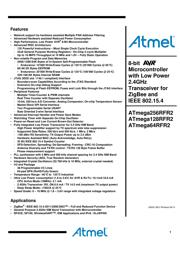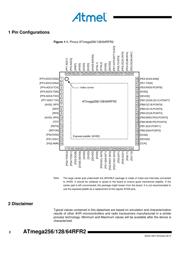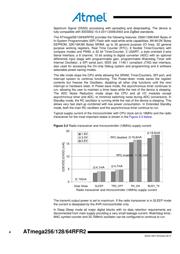Datasheet 搜索 > 微控制器 > Microchip(微芯) > ATMEGA256RFR2-ZU 数据手册 > ATMEGA256RFR2-ZU 用户编程技术手册 5/611 页

 器件3D模型
器件3D模型¥ 22.406
ATMEGA256RFR2-ZU 用户编程技术手册 - Microchip(微芯)
制造商:
Microchip(微芯)
分类:
微控制器
封装:
QFN-64
描述:
8 位 megaAVR 微控制器,32KB 到 256KB 闪存我们在 RS Components 提供多款来自 Atmel 的 megaAVR 8 位微控制器。 每个微控制器均基于增强型 RISC 体系结构,并具有 QTouch 库支持。 所有微控制器类型具有不同 Kb 的系统内可编程内存、EEPROM 和 SRAM 以及不同引脚和封装类型。 **megaAVR 8 位微控制器类型** ATmega32 ATmega64 ATmega128 ATmega324 ATmega325 ATmega406 ATmega640 ATmega644 ATmega645 ATmega1280 ATmega1281 ATmega1284 ATmega2560 ATmega2561 ATmega3250 ATmega6450
Pictures:
3D模型
符号图
焊盘图
引脚图
产品图
页面导航:
引脚图在P2P5P221P258P276P341Hot
典型应用电路图在P87P181P540
原理图在P3P9P33P46P80P82P85P87P96P194P219P258
型号编码规则在P594P595P596
封装信息在P597
功能描述在P67P363
技术参数、封装参数在P81P95P105P110P553P564P566
应用领域在P1P97P183P209P245P249P487P504P505P540P542P555
电气规格在P77P182P192P206P207P219P236P237P446P448P553P557
导航目录
ATMEGA256RFR2-ZU数据手册
Page:
of 611 Go
若手册格式错乱,请下载阅览PDF原文件

5
8393C-MCU Wireless-09/14
ATmega256/128/64RFR2
The device is manufactured using Atmel’s high-density nonvolatile memory technology.
The On-chip ISP Flash allows the program memory to be reprogrammed in-system
trough an SPI serial interface, by a conventional nonvolatile memory programmer, or by
on on-chip boot program running on the AVR core. The boot program can use any
interface to download the application program in the application Flash memory.
Software in the boot Flash section will continue to run while the application Flash
section is updated, providing true Read-While-Write operation. By combining an 8 bit
RISC CPU with In-System Self-Programmable Flash on a monolithic chip, the Atmel
ATmega256/128/64RFR2 is a powerful microcontroller that provides a highly flexible
and cost effective solution to many embedded control applications.
The ATmega256/128/64RFR2 AVR is supported with a full suite of program and system
development tools including: C compiler, macro assemblers, program
debugger/simulators, in-circuit emulators, and evaluation kits.
3.2 Pin Descriptions
3.2.1 EVDD
External analog supply voltage.
3.2.2 DEVDD
External digital supply voltage.
3.2.3 AVDD
Regulated analog supply voltage (internally generated).
3.2.4 DVDD
Regulated digital supply voltage (internally generated).
3.2.5 DVSS
Digital ground.
3.2.6 AVSS
Analog ground.
3.2.7 Port B (PB7...PB0)
Port B is an 8-bit bi-directional I/O port with internal pull-up resistors (selected for each
bit). The Port B output buffers have symmetrical drive characteristics with both high sink
and source capability. As inputs, Port B pins that are externally pulled low will source
current if the pull-up resistors are activated. The Port B pins are tri-stated when a reset
condition becomes active, even if the clock is not running.
Port B also provides functions of various special features of the
ATmega256/128/64RFR2.
3.2.8 Port D (PD7...PD0)
Port D is an 8-bit bi-directional I/O port with internal pull-up resistors (selected for each
bit). The Port D output buffers have symmetrical drive characteristics with both high sink
and source capability. As inputs, Port D pins that are externally pulled low will source
current if the pull-up resistors are activated. The Port D pins are tri-stated when a reset
condition becomes active, even if the clock is not running.
Port D also provides functions of various special features of the
ATmega256/128/64RFR2.
3.2.9 Port E (PE7...PE0)
Port E is an 8-bit bi-directional I/O port with internal pull-up resistors (selected for each
bit). The Port E output buffers have symmetrical drive characteristics with both high sink
and source capability. As inputs, Port E pins that are externally pulled low will source
器件 Datasheet 文档搜索
AiEMA 数据库涵盖高达 72,405,303 个元件的数据手册,每天更新 5,000 多个 PDF 文件






